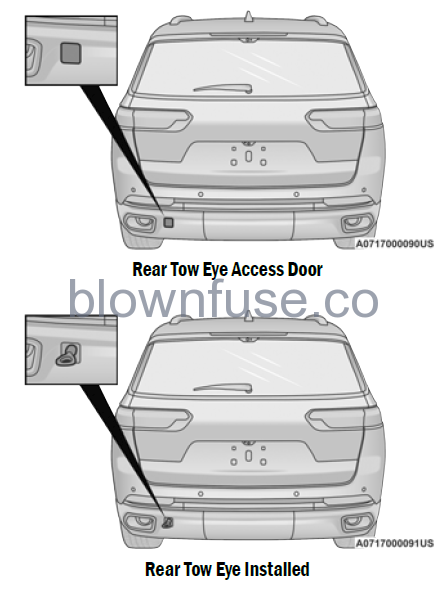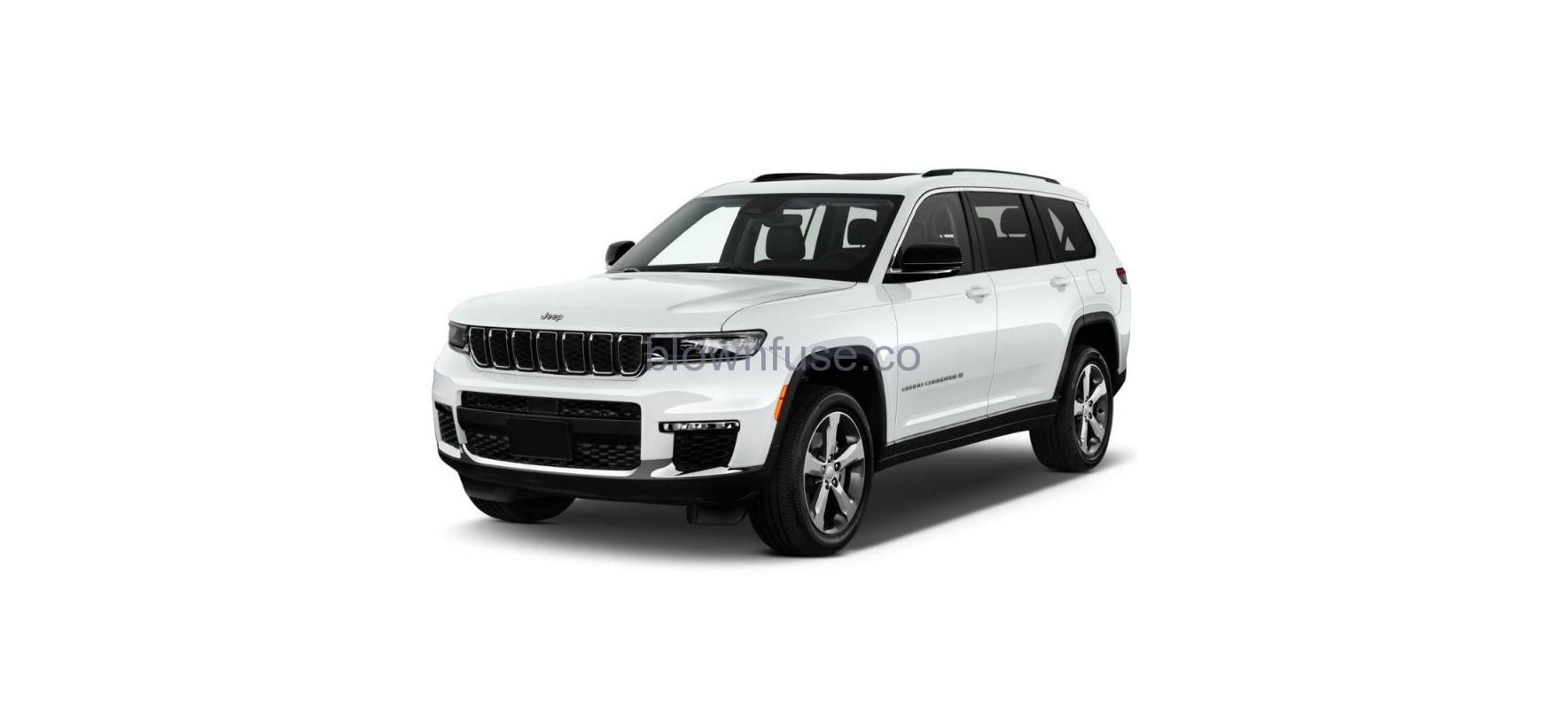2022 Jeep Grand Cherokee Towing a Disabled Vehicle User Guide

TOWING A DISABLED VEHICLE
This section describes procedures for towing a disabled vehicle using a commercial towing service.
If the transmission and drivetrain are operable, disabled 4×4 vehicles may also be towed as described on page 196.
|
Towing Condition |
Wheels OFF The Ground |
Rear-Wheel Drive Models |
All-Wheel Drive Models With Single-Speed Transfer Case |
All-Wheel Drive Models With Two-Speed Transfer Case |
|
Flat Tow |
NONE |
NOT ALLOWED |
NOT ALLOWED |
Detailed Instructions page 196.
l Transmission in PARK l Transfer case in NEUTRAL (N) l Tow in forward direction |
|
Wheel Lift Or Dolly Tow |
Front | NOT ALLOWED | NOT ALLOWED | NOT ALLOWED |
| Rear | OK | NOT ALLOWED | NOT ALLOWED | |
| Flatbed | ALL | BEST METHOD | OK | BEST METHOD |
Proper towing or lifting equipment is required to prevent damage to your vehicle. Use only tow bars and other equipment designed for this purpose, following the equipment manufacturer’s instructions. Use of safety chains is mandatory. Attach a tow bar or other towing device to main structural members of the vehicle, not to fascia/bumpers or associated brackets. State and local laws regarding vehicles under tow must be observed.
If you must use the accessories (wipers, defrosters, etc.) while being towed, the ignition must be in the ON/RUN mode, not the ACC mode.
If the vehicle’s battery is discharged, instructions on shifting the automatic transmission out of PARK (P) in order to move the vehicle page 326.\
CAUTION!
- Do not use sling-type equipment when towing. Vehicle damage may occur.
- When securing the vehicle to a flatbed truck, do not attach to the front or rear suspension components. If the vehicle is equipped with Quadra-lift air suspension, secure vehicle only with tire/wheel straps (no suspension components or body) to prevent air suspension from adjusting during towing against securement straps and causing damage. Damage to your vehicle may result from improper towing.
REAR WHEEL DRIVE MODELS
FCA US LLC recommends towing your vehicle with all four wheels OFF the ground using a flatbed.
If flatbed equipment is not available, and the transmission is operable, the vehicle may be towed (with rear wheels off the ground) under the following conditions:
- The transmission must be in NEUTRAL (N). For instructions on shifting the transmission to NEUTRAL (N) when the engine is off page 326.
- The towing speed must not exceed 30 mph (48 km/h).
- The towing distance must not exceed 30 miles (48 km).
CAUTION!
- Towing faster than 30 mph (48 km/h) or farther than 30 miles (48 km) with rear wheels on the ground can cause severe trans-mission damage. Damage from improper towing is not covered under the New Vehicle Limited Warranty.
If the transmission is not operable, or the vehicle must be towed faster than 30 mph (48 km/h) or farther than 30 miles (48 km), tow with the rear wheels OFF the ground. Acceptable methods are to tow the vehicle on a flatbed, or with the front wheels raised and the rear wheels on a towing dolly, or (when using a suitable steering wheel stabilizer to hold the front wheels in the straight position) with the rear wheels raised and the front wheels ON the ground.
ALL WHEEL DRIVE MODELS
FCA US LLC recommends towing with all wheels OFF the ground. Acceptable methods are to tow the vehicle on a flatbed or with one end of the vehicle raised and the opposite end on a towing dolly. If flatbed equipment is not available, and the transfer case is operable, vehicles with a
two-speed transfer case may be towed (in the forward direction, with ALL wheels on the ground), IF the transfer case is in NEUTRAL (N) and the transmission is in PARK page 196.
Vehicles equipped with a single-speed transfer case have no NEUTRAL (N) position, and therefore must be towed will all four wheels OFF the ground.
CAUTION!
- Front or rear wheel lifts must not be used (if the remaining wheels are on the ground). Internal damage to the transmission or transfer case will occur if a front or rear wheel lift is used when towing.
- Towing this vehicle in violation of the above requirements can cause severe transmission and/or transfer case damage. Damage from improper towing is not covered under the New Vehicle Limited Warranty.
EMERGENCY TOW HOOKS — IF EQUIPPED
If your vehicle is equipped with tow hooks, there will be two mounted on the front of the vehicle and one in the rear. The rear tow hook will be located on the driver’s side of the vehicle.
CAUTION!
Tow hooks are for emergency use only, to rescue a vehicle stranded off road. Do not use tow hooks for tow truck hookup or highway towing. You could damage your vehicle.
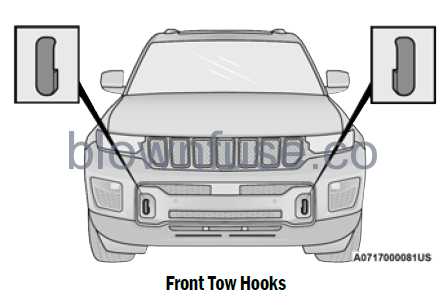
NOTE:
For off road recovery, it is recommended to use both of the front tow hooks to minimize the risk of damage to the vehicle.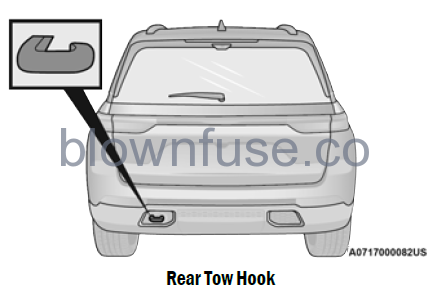
WARNING!
- Do not use a chain for freeing a stuck vehicle. Chains may break, causing serious injury or death.
- Stand clear of vehicles when pulling with tow hooks. Tow straps may become disengaged, causing serious injury.
TOW EYE USAGE — IF EQUIPPED
Your vehicle may come equipped with a front tow eye that can be used to move a disabled vehicle.
When using a the tow eye, follow the precautions below.
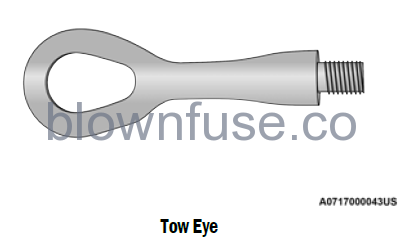
Tow Eye Usage Precautions
CAUTION!
- The tow eye must only be used for roadside emergencies. Use with an appropriate device in accordance with highway code (a rigid bar or rope) to maneuver the vehicle in preparation for transport via a tow truck.
- The tow eye must not be used to move the vehicle off the road or where there are obstacles.
- Do not use the tow eyes for tow truck hookup or highway towing.
- Do not use the tow eye to free a stuck vehicle page 328.
- Damage to your vehicle may occur if these guidelines are not followed page 329.
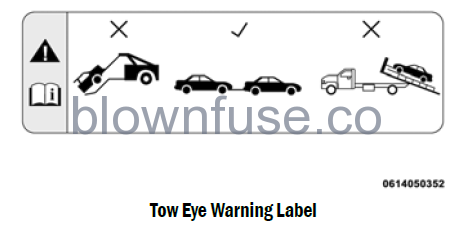
WARNING!
Stand clear of vehicles when pulling with tow eyes.
- Do not use a chain with a tow eye. Chains may break, causing serious injury or death.
- Do not use a tow strap with a tow eye. Tow straps may break or become disengaged, causing serious injury or death.
- Failure to follow proper tow eye usage may cause components to break resulting in serious injury or death.
Tow Eye Installation
The front tow eye receptacle is located behind a door on the passenger’s side of the fascia/bumper.
To install the tow eye, open the door using the vehicle key or a small screwdriver. Thread the tow eye into the receptacle, making sure it is fully tightened.
The tow eye must be securely seated to the attaching bracket through the lower front fascia/bumper. If the tow eye is not securely seated to the attaching bracket, the vehicle should not be moved.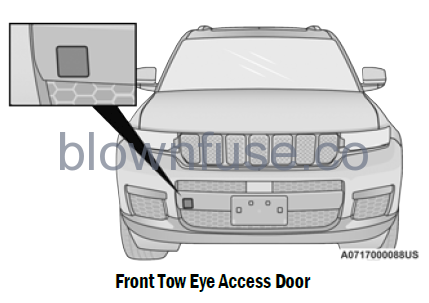
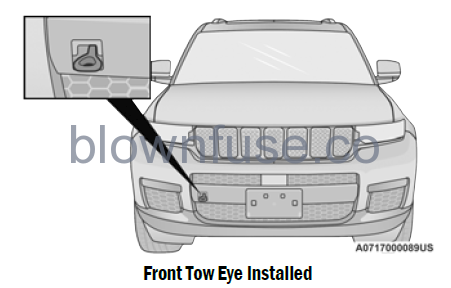
The rear tow eye receptacle is located behind a door on the driver’s side of the rear fascia/bumper.
To install the tow eye, open the door using the vehicle key or a small screwdriver. Thread the tow eye into the receptacle, making sure it is fully tightened.
The tow eye must be securely seated to the attaching bracket through the lower front fascia/bumper. If the tow eye is not securely seated to the attaching bracket, the vehicle should not be moved.
